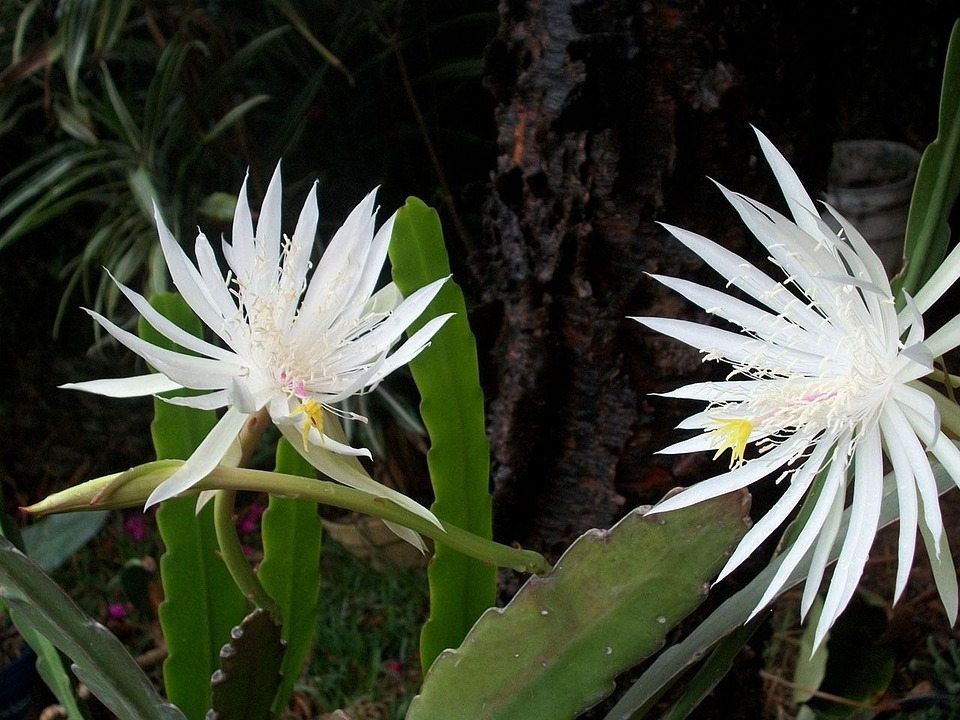The Cereus Night-Blooming Flower, a marvel of the botanical world, possesses an enigmatic charm that captivates enthusiasts and casual observers alike. As dusk falls, this extraordinary cactus reveals its ethereal beauty, beckoning us to ponder: What can we learn from a flower that flourishes under the shroud of night? This delightful challenge to the observer’s senses invites a deeper examination into the life cycle, habitat preferences, and the allure of this nocturnal spectacle.
The night-blooming cereus, often associated with the genus Cereus, is an iconic representative of cacti known for its resplendent blooms, which unfurl magnificently in the cool embrace of twilight. While many plants shy away from the dark, this cactus embraces it, prompting one to consider how resilience and adaptability shape survival in the wild.
One cannot help but wonder, amid the complexities of modern life, if there is wisdom to be gleaned from the nocturnal revelry of the night-blooming cereus. How does this flower not only thrive but also create an unforgettable experience under the moonlight?
Exploring the Allure of Nocturnal Beauty
The night-blooming cereus is categorized into multiple species, with the most iconic being the Queen of the Night, or Selenicereus undatus. This stunning flower typically showcases its delicate petals for just a single night, perfuming the air with an intoxicating fragrance that attracts nocturnal pollinators such as moths. In essence, this ephemeral beauty begs the question: How can something so fleeting evoke such profound fascination?
When the sun sets, the blooms begin to unfurl, revealing a captivating white flower, often measuring up to a foot in diameter. This dramatic display is unparalleled in the plant kingdom, transforming the landscape under the bewitched gaze of the night sky. The petals shimmer like a silken shroud, leaving observers spellbound as they bask in the floral grandeur before it wilts by dawn. The cyclical nature of this phenomenon serves as a poignant reminder of the transient beauty inherent in life itself, posing a challenge for gardeners and nature lovers alike: How can we cultivate patience and appreciation for fleeting moments in our own lives?
Habitat and Natural Environment
This resilient cactus primarily inhabits the arid regions of Central and South America, thriving in sandy, well-drained soils. Adapted to the harsh conditions, the night-blooming cereus displays remarkable resilience, often growing in harsh environments that would thwart less adaptive species. It possesses an extensive root system designed to absorb moisture during infrequent rains, optimizing its survival prospects. The cactus’s ability to conserve energy during daylight hours while conserving moisture is a field of study worthy of deeper exploration.
In its native habitat, the night-blooming cereus tends to climb and thrive among other plants, forging symbiotic relationships which not only enhance its growth but also sustain the local ecosystem. This interconnection emphasizes a critical topic: the role each species plays within its ecosystem. It invites contemplation on how we interact with our environment and the implications of disrupting such delicate balances.
Cultural Significance and Folklore
The night-blooming cereus has captured the hearts and imaginations of many cultures, often woven into the fabric of local mythologies. In some communities, its rare blooms symbolize love and beauty, while in others, it represents the eternal cycle of life and death. The specter of the flower’s fleeting existence has garnered countless tales surrounding its appearance, often marking significant life events. It is said that witnessing a night bloom heralds transformative moments, creating a sense of connection between human experiences and nature’s rhythms.
The serene atmosphere enveloped by the night-blooming cereus lends itself to joyful gatherings and contemplative solitude alike. Many gardeners host “Night Blooming Parties,” embracing the fleeting blooms with friends and family under a starlit sky. This tradition serves as an opportunity to celebrate the night-blooming cereus, forging bonds while basking in the mysterious allure of its flowers. The question arises: How often do we take the time to pause, reflect, and celebrate the beauty that exists around us?
The Challenge of Cultivation
For those intrigued by the garden potential of the night-blooming cereus, growing this enchanting cactus can be both rewarding and challenging. It demands specific conditions to flourish—a sunny yet sheltered location and well-draining soil enriched with organic matter. The challenge lies in providing adequate care without overindulgence; excessive watering can lead to root rot, thus defeating the purpose of nurturing this delicate bloom. It urges cultivators to embrace a philosophy of balance—tending to the needs of the plant while respecting its natural inclinations.
Moreover, timing is crucial for enthusiasts keen to witness the orchid-like blooms. The flowering season typically peaks in late spring to early summer, instituting a short window of opportunity for appreciation. Observers face the delightful dilemma of aligning their schedules to catch the petals unfurling at night—a singular experience requiring dedication and patience.
In conclusion, the Cereus Night-Blooming Flower stands as a testament to nature’s capacity for wonder and mystery. It encourages thoughtful introspection, leading us to marvel at life’s transient beauty. Nature speaks volumes through its ephemeral flowers, inviting us to pause amidst our hurried existence—to appreciate the night blooms, the intricate connections of our ecosystem, and the delicate balance we strive to maintain. The lesson is clear: it is often in the fleeting moments that we find the most profound experiences.





Leave a Comment